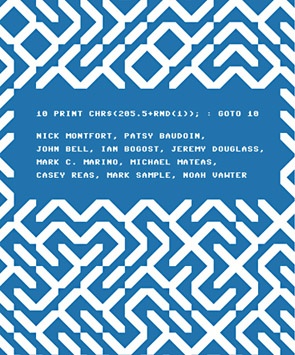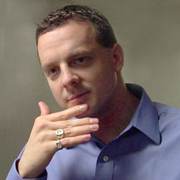Spotlight | CMS
Montfort and colleagues reveal stories in BASIC code
A special line of code
This collaboratively written book takes a single line of code—the extremely concise BASIC program for the Commodore 64 inscribed in the book's title—and uses it as a lens through which to consider the phenomenon of creative computing and the way computer programs exist in culture.
As a book title, 10 PRINT CHR$(205.5+RND(1)); : GOTO 10 (MIT Press, 2012) does not exactly roll off the tongue. But as computer code, it has the quality of concrete poetry in the eyes of Nick Montfort,associate professor of digital media in the Comparative Media Studies/Writing program at MIT.
The lead author of the book we’ll just call 10 PRINT, Montfort identifies code as a culturally significant human language, as deserving of close critical analysis as other products of culture. “No one would be startled to ask why this word was used [in literature]. Why can’t we do that with a line of code?”
Written for the Commodore 64, one of the earliest personal computers (released in 1982), “10 PRINT CHR$(205.5+RND(1)); : GOTO 10” is a line of code in BASIC, the first widely popular programming language designed for use by non-scientists. When executed, the code randomly—and repeatedly—generates either a / or a \, filling the screen with a pattern that resembles a maze.
“The emergent complexity from this deceptively simple work is part of its interest,” says Montfort, noting that while not all code can be considered poetic, 10 PRINT is special. “I believe it is a concrete poem, a found poem. It’s a cultural artifact.”
Full Story at MIT SHASS News
10 Print Authors
Nick Montfort is Associate Professor of Digital Media at MIT and the coauthor of Racing the Beam: The Atari Video Computer System (MIT Press, 2009).
Patsy Baudoin is the MIT Libraries liaison to the MIT Media Lab.
John Bell is Assistant Professor of Innovative Communication Design at the University of Maine.
Ian Bogost is Professor of Digital Media at the Georgia Institute of Technology, a Founding Partner at Persuasive Games LLC, and the coauthor of Newsgames: Journalism at Play (MIT Press, 2010) and other books.
Jeremy Douglass is a postdoctoral researcher in software studies at the University of California, San Diego, in affiliation with Calit2.
Mark C. Marino is Associate Professor (Teaching) and directs the Humanities and Critical Code Studies (HaCCS) Lab at the University of Southern California.
Michael Mateas is Associate Professor of Computer Science at the University of California, Santa Cruz.
Casey Reas is Professor of Design Media Arts at UCLA and coauthor of Processing: A Programming Handbook for Visual Designers and Artists (MIT Press, 2007).
Mark Sample is Assistant Professor of English at George Mason University.
Noah Vawter is a sound artist.

"Like a diary from the forgotten past, computer code is embedded with stories of a program’s making, its purpose, its assumptions, and more. Every symbol within a program can help to illuminate these stories and open historical and critical lines of inquiry.”

Suggested Links
Nick Montfort
MIT SHASS | Comparative Media Studies
10 PRINT CHR$(205.5+RND(1)); : GOTO 10